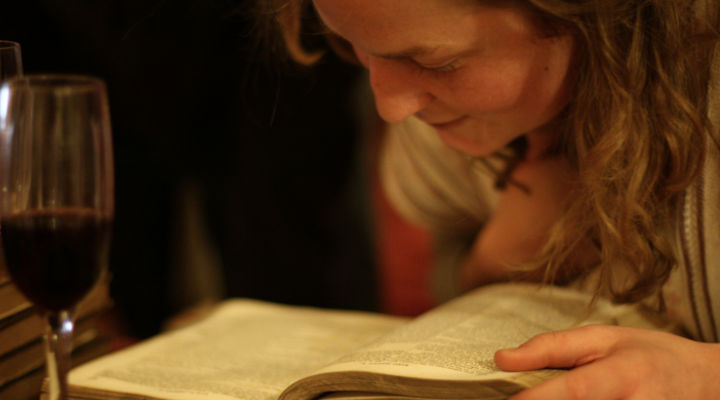Ways of reading a poem

Two attitudes towards poetry: Odi et amo (‘I hate and I love’, Catullus 85).
Among English literature students, I have mainly encountered two kinds of attitudes towards poetry: love and hatred.
The poetry-loving student studies English precisely because of poetry—this type of student writes, or at least attempts to write, poetry while reading works of the Great Masters; in the seminar, such students often feel and behave as if they were the “chosen” ones by the Muses of Poesy.
The poetry-hating student, on the other hand, is into fiction and/or drama, and looks at the poetry-loving student with a certain amount of distrust, awe, and caution, believing – to quote an anonymous student of this second category – that they are just ‘not poetry savvy’ enough. The novel-lovers will look at the poems in handouts with fear and circumspection: ‘I thought this wasn’t going to be a poetry module! Why am I given verse to read?’
Some may even pay you a visit at office hours to ask for remission of their poetic ineptitude, which burdens their conscience: ‘I feel lost reading poetry without annotations, and what do I do if I just can’t get my head round poetry?’ And so on, and so forth. But the thing is, you’re bound to encounter poetry in an English literature degree, and in this page we shall offer some common antidotes to the disease of the dislike of poetry.
P.S.: there is no such thing as being (or not being) poetry savvy.
Some Antidotes to the Hatred of Poetry (or Four Ways of Looking at Poetry)
If you like music, you’ll like poetry.
Poetry was originally meant to be recited aloud. Just looking at the page will not help very much: most times, you will need to read it out. Read it out loud in your room, when preparing for the seminar: enjoy the sound that each word does coming out of your mouth; put up accents; read it slowly, read it quickly; hear harder and softer consonants; hear its rhythm; and remember it is OK to stumble, too.
For example, try read the first stanza of Dylan Thomas’ ‘Do Not Go Gentle Into That Good Night’:
Do not go gentle into that good night,
Old age should burn and rave at close of day;
Rage, rage against the dying of the light.
What is the rhythm of this first stanza? Slow or fast? How is the rhythm rendered? Think about those short words at the beginning of each line – do, not, go; old, age; rage, rage. What metre is Thomas using? How is the guttural ‘g’ used in this stanza? And how about the ‘r’? If this poem were a song, what kind of song would it be?
If you like paintings, you’ll like poetry.
Poetry is an art in itself, of course, but it often intersects with the visual arts, and a way of reading poetry is to understand its aesthetics as well as its visual appeal.
Conjure up in your head the image the poet wants you to experience: the first time you do this, try not to get fixated on the meaning of each word; the second time, look up unusual words in the dictionary (ie the OED) and create an even more precise mental image of the poem.
Sometimes, poems directly refer to images and looking those up will improve your understanding of the poetry. Compare, for example, the first stanza of Oscar Wilde’s ‘Impression du Matin’ with one of James Abbott McNeill Whistler’s nocturnes:
The Thames nocturne of blue and gold
Changed to a Harmony in grey:
A barge with ochre-coloured hay
Dropt from the wharf: and chill and cold
How do Wilde’s words manage to summon up an image that’s similar/different from a painting by Whistler? How does his use of rhyme manage to lock and intertwine colours and emotions? Can we use art terminology to comment on this poem?
If you like photography, you’ll like poetry.
Think of the poet as a photographer, showing us a very personal angle to the world via his/her poetry, which works effectively like a camera. In fact, photography and poetry share the same ability to be succinct, while being emotionally and visually evocative. Analyse a poem as if it were an image, a painting, a photograph. Take Ezra Pound’s famous, haiku-inspired short poem ‘In a Station of the Metro’:
The apparition of these faces in the crowd;
Petals on a wet, black bough
Consider Pound’s choice of words: how do they contribute to the immediacy of the image? Could we paint/film/photograph a similar moment? How does the title interact with the actual body of the poem?
Poetry can also recreate actual images on the page – take visual poetry, for example (see Futurism, Concrete Poetry, Imagism, etc.). Consider, for instance, the graphic position of William Carlos Williams’ ‘The River of Heaven’: the poem becomes a river on the page, where words fluctuate on the page as if liquid.
If you like craft, you’ll like poetry.
Who said poetry is just about being inspired by the Muses? Poetry as a long-crafted product---something shaped by time and experience, only at times encouraged by success, and more often than not blossoming out of failure and resilience.
Take your time exploring its apparent and hidden structures, its half-rhymes, its internal rhymes, its form, its metre, its repetitions, its recurring symbols and metaphors, its title, its imagery, its musicality, its engagement with life, the sublime and the everyday---read poetry as you would inspect a well-crafted object.
Nicoletta Asciuto April 2018
- This article is available to download for free as a PDF for use as a personal learning tool or for use in the classroom as a teaching resource: Ways of Reading a Poem (PDF
 , 768kb)
, 768kb)
